You'll need basic equipment like a sturdy cardboard box, aluminum foil, and clear plastic wrap to start solar cooking anywhere in the world. Adapt your cooking strategy to your climate: start early in desert regions, use shade trees in tropical areas, and position cookers at steeper angles during winter. For ideal results, layer ingredients strategically and adjust your reflectors regularly to track the sun. Don't forget to match your menu to seasonal patterns – lighter dishes work better in winter, while summer allows for more complex meals. These climate-smart fundamentals will set you up for successful outdoor cooking adventures worldwide.
Essential Solar Cooking Equipment
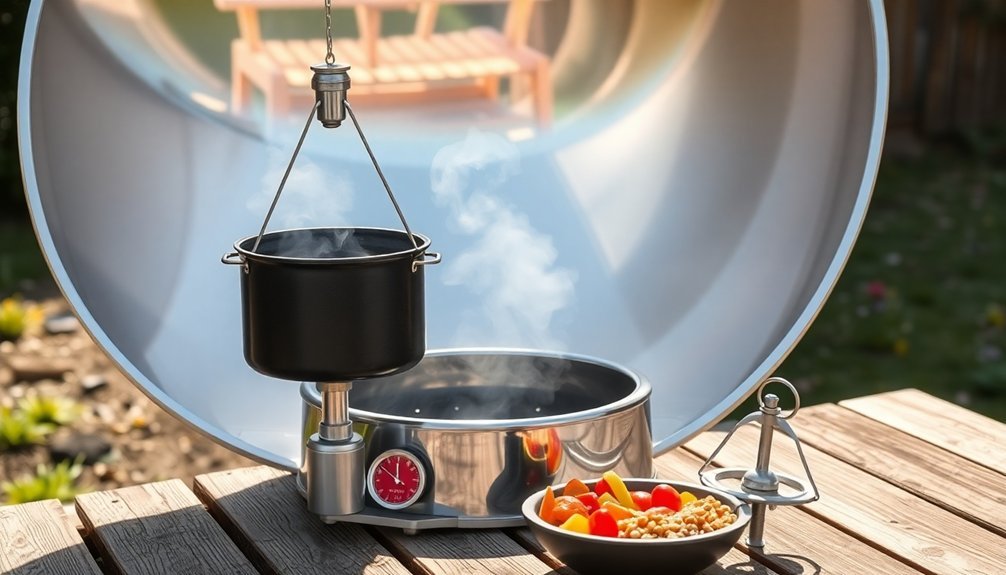
A well-equipped solar kitchen starts with the right tools and materials for harnessing the sun's energy.
You'll need a sturdy cardboard box, whether it's a pizza box for small meals or a large appliance carton for family-sized portions. Prop the flap open at the optimal angle to maximize sunlight reflection into your cooking chamber. Aluminum foil serves as your reflective surface, while clear plastic wrap creates a transparent barrier to trap heat.
For heat absorption, gather black construction paper and dark-colored pots. You'll also want newspapers or foam for insulation, and a thermometer to monitor cooking temperatures.
Don't forget basic tools like scissors, clear tape, and a foam paintbrush for assembly. To guarantee your setup is secure and weatherproof, keep duct tape handy.
These materials let you build any style of solar cooker, from simple panel designs to more complex box or parabolic models.
Mastering Desert Solar Cooking
Building on your solar cooking equipment foundation, mastering desert solar cooking requires unique strategies to overcome challenging weather patterns.
You'll need to start early in the morning before monsoon clouds gather, and constantly monitor weather conditions to adjust your cooking approach. High thin clouds can decrease your cooking efficiency by up to 50%.
Position your solar oven with reflective surfaces and clear lids to maximize sunlight exposure, and don't forget to rotate it as the sun moves.
Begin with simple dishes like rice or vegetables while you learn the timing nuances. You can maintain food warmth using hay box cookers when clouds appear.
The rewards are worth the effort – you'll save energy, reduce fire risks, and even purify water. Plus, you'll have a reliable cooking method during emergencies or power outages.
Remember to stay patient, as solar cooking takes longer than conventional methods.
Tropical Climate Cooking Tips
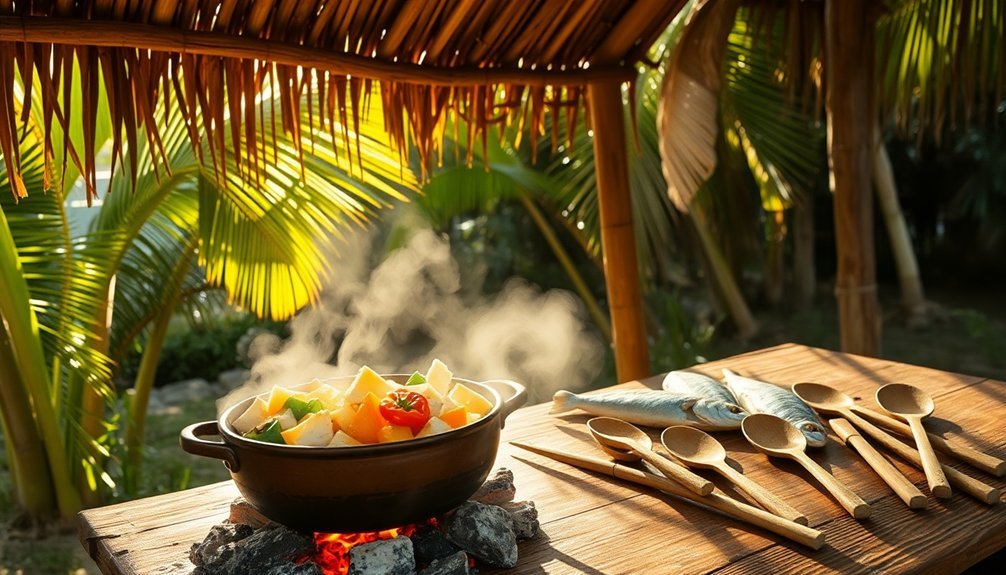
When cooking outdoors in tropical climates, you'll want to position your cooking station under shade trees to reduce heat and conserve energy while protecting ingredients from direct sun exposure.
Control moisture by keeping ingredients covered and elevated on racks, while using traditional methods like banana leaf wrapping to prevent excess humidity from affecting food quality.
Let natural air flow work to your advantage by setting up your cooking area where prevailing breezes can help ventilate smoke and regulate temperature. Traditional Caribbean cooking often relies on low and slow cooking techniques that work particularly well in outdoor tropical settings.
Shade Trees Save Energy
Savvy tropical climate dwellers know that shade trees offer more than just a pleasant spot for outdoor dining.
You'll discover that strategically placed trees can slash your cooling costs by up to 30% while creating the perfect environment for your outdoor kitchen setup.
When you're planning your outdoor cooking space, position deciduous trees on your home's south, west, or east sides. They'll block up to 90% of summer sun but allow winter warmth through their bare branches.
For year-round protection, plant evergreens as windbreaks – they'll cut your heating costs by 10-50%.
You'll feel the difference immediately, as temperatures under trees can be 25°F cooler than nearby pavement.
Plus, each tree you plant saves enough electricity to power your home for about a week, making your outdoor cooking area both comfortable and energy-efficient.
Moisture Control Methods
While shade trees help manage outdoor temperatures, controlling moisture is another key aspect of comfortable outdoor cooking in tropical climates. You'll want to create good air circulation by setting up your cooking area where natural breezes flow. Install mesh screens (5mmx5mm) around your outdoor kitchen to keep insects out while allowing proper ventilation.
| Control Method | Best When | Avoid When |
|---|---|---|
| Misting System | Humidity < 75% | Humidity > 80% |
| Natural Ventilation | Mild breeze | Strong winds |
| Heat Pipes | High humidity | Low temperatures |
For effective moisture control, position your cooking station to take advantage of natural convection currents. If you're using a misting system, keep cycles short (1-3 seconds) and monitor humidity levels closely. Remember that temperature and humidity work together, so managing both simultaneously will create the most comfortable cooking environment.
Natural Ventilation Techniques
Natural ventilation can transform your tropical outdoor kitchen from a sweltering space into a comfortable cooking haven.
Position your cooking area in a semi-enclosed space that captures prevailing breezes, and remove unnecessary partitions that could block airflow. You'll want to maximize openings by installing louvers or casement windows strategically around your cooking space.
Take advantage of stack ventilation by incorporating design elements like pergolas or awnings that help channel warm air upward while drawing in cooler air below.
Plant trees or shrubs nearby to enhance airflow and provide natural cooling. If you're building from scratch, consider adding an air well or interior courtyard – these features create pressure differences that boost ventilation.
Remember to keep your layout narrow and open to optimize cross-ventilation throughout your cooking space.
Winter Solar Cooking Strategies
Despite shorter days and lower sun angles, winter solar cooking remains feasible with proper adjustments and strategies.
You'll need to maximize your cooker's exposure by setting it at steeper angles and positioning it on its narrowest side. For best results, use stabilizers like bricks to prevent tipping.
Start cooking earlier in the day and track the sun's movement frequently. You can take advantage of winter's clearer air and snow reflection to enhance cooking efficiency.
If needed, cook in stages over multiple days, storing partially cooked food in your refrigerator overnight. To maintain heat in cold weather, use additional insulation like oven roasting bags and keep your cooker indoors before use.
Remember to minimize opening the cooker and rely on steam as an indicator of food completion.
Adapting Recipes For Solar Heat
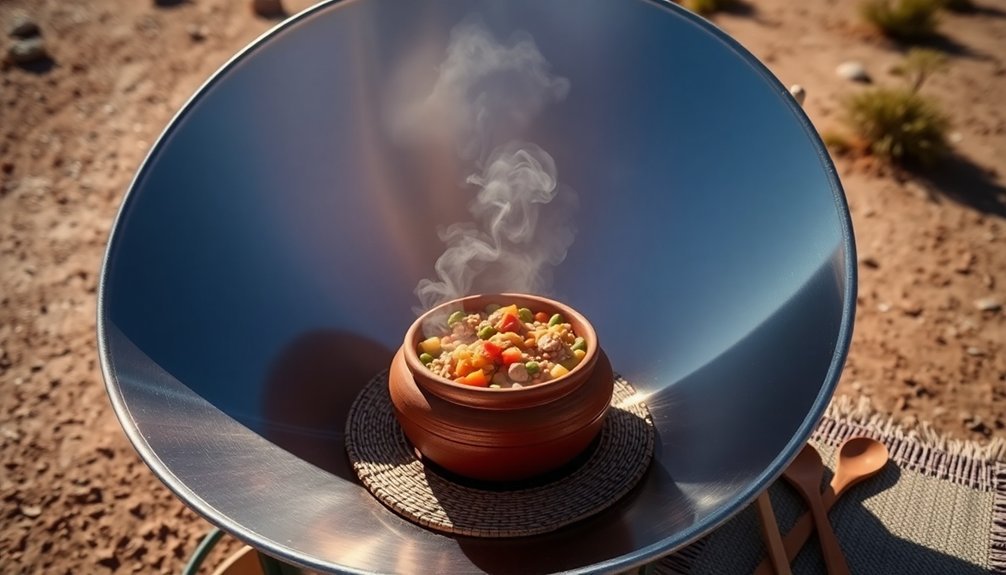
You'll need to position your reflective cooking surfaces strategically to match your recipe's temperature requirements, using parabolic cookers for high-heat dishes and panel cookers for gentler cooking methods.
Based on seasonal sunlight patterns, plan your solar menu accordingly—lighter dishes during winter months and more complex meals during peak summer sun.
To maintain consistent temperatures, utilize transparent heat traps like glass bowls or clear plastic bags, which help you achieve the ideal cooking environment for each specific dish.
Reflective Cooking Surface Setup
Mastering reflective cooking surfaces opens up creative possibilities for eco-friendly outdoor meal preparation. You'll need aluminum foil or shiny metal surfaces to concentrate heat effectively, whether you're using sunlight or fire.
Combine these with cardboard, insulation, and Plexiglas for ideal heat retention in solar ovens.
When setting up your reflective cooking area, position the surfaces at slanting angles to direct heat evenly onto your food. If you're using a fire, build it teepee-style to match your cooking shelf's height.
For maximum efficiency, you can place two reflector ovens across from each other. Remember to adjust your reflectors regularly to capture the most heat, and confirm you've got proper insulation to prevent heat loss through conduction.
Seasonal Solar Recipe Planning
When planning recipes for solar cooking, adapting traditional dishes to work with seasonal ingredients and natural heat sources requires strategic modifications. You'll want to select locally available produce and climate-resistant crops while adjusting cooking times for solar heat. Cut ingredients into smaller pieces and layer them properly to guarantee even cooking.
| Season | Best Ingredients | Cooking Tips |
|---|---|---|
| Summer | Fresh vegetables, herbs, shrimp | Preheat 30 min, use peak sun hours |
| Fall | Root vegetables, preserved tomatoes | Add moisture-rich sauces |
| Winter | Canned goods, hardy greens | Insulate well, batch cook items |
Maximize efficiency by cooking multiple dishes simultaneously during peak sunlight. Don't forget to incorporate cultural flavors through spices and herbs while maintaining nutritional balance. You'll find that marinating proteins and using oils helps retain moisture during longer cooking times.
Temperature Control Methods
Successful solar cooking relies heavily on precise temperature control methods to adapt traditional recipes.
You'll need to master your grill's damper system, starting with the bottom vents fully open while adjusting the top lid damper for different heat levels: fully open for high heat, half for medium, and quarter for low cooking temperatures.
For ideal temperature management, arrange your charcoal strategically.
Create even layers for general cooking or set up two-zone fires when you need both hot and slow cooking areas.
Keep your thermometer near the cooking grate for accurate readings, and don't rely solely on lid thermometers.
Remember to keep the lid closed to maintain steady temperatures, and clean your grill regularly for proper airflow.
Adjust your approach based on weather conditions, as wind and outdoor temperatures will affect your cooking.
Weather Pattern Cooking Guide
Understanding weather patterns can revolutionize your outdoor cooking approach, whether you're planning a summer barbecue or a winter cookout.
You'll need to adapt your cooking methods and ingredient choices based on the weather to guarantee the best results.
1. Hot and Humid Days: Keep your meals light and quick-cooking.
Choose cold cuts, salads, and fish that won't require long cooking times.
Store dry ingredients in the refrigerator to prevent clumping.
2. Cold Weather Cooking: Adjust your recipes with extra moisture for dry winter air.
You'll want heartier dishes that provide warmth and comfort.
3. Extreme Conditions: Always have a backup plan for unexpected weather changes.
Keep non-perishable ingredients on hand, and be prepared to modify cooking times based on temperature fluctuations.
High Altitude Solar Methods
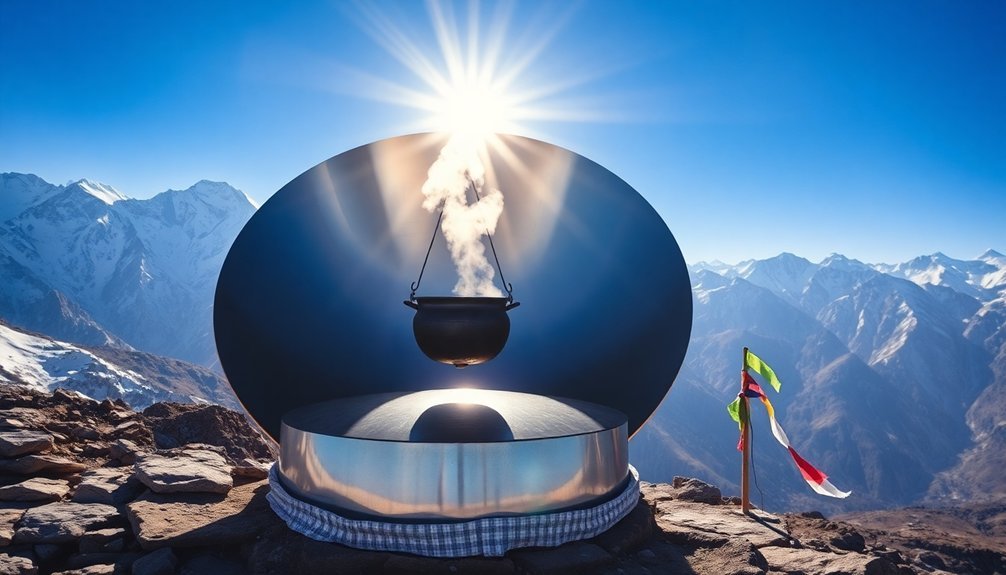
Beyond traditional weather considerations, high-altitude locations offer unique advantages for solar cooking. You'll find stronger solar radiation and less atmospheric interference, which means faster cooking times and higher temperatures for your outdoor meals.
To maximize your high-altitude solar cooking success, choose the right equipment. Parabolic cookers and vacuum tube models work exceptionally well, while box and panel cookers need more time to heat.
You'll want to protect your setup from strong winds and position it in direct sunlight. Boost your cooker's efficiency by painting the interior black and adding thermal mass like a brick.
Don't forget to use reflective materials such as aluminum foil or Mylar tape. For best results, preheat your cooker for 30 minutes and tilt it to capture peak sunlight based on your location.
Seasonal Food Preparation Techniques
When planning outdoor meals throughout the year, seasonal food preparation can make a significant difference in both flavor and sustainability.
You'll enhance your outdoor dining experience by sourcing fresh ingredients from local farmers' markets or joining CSA programs. By choosing ripe, seasonal produce and experimenting with grilling fruits, you'll create unique flavors while supporting local agriculture.
- Pre-pack your ingredients in labeled zip-top bags and marinate meats ahead of time to maximize flavor and efficiency.
- Keep food safe by maintaining proper temperatures (35°F-40°F) and using ice blocks instead of cubes.
- Use different cooking techniques like grilling, smoking, or campfire cooking to infuse distinct flavors, and don't forget to create separate zones for direct and indirect heat when grilling.
Regional Solar Cooking Variations
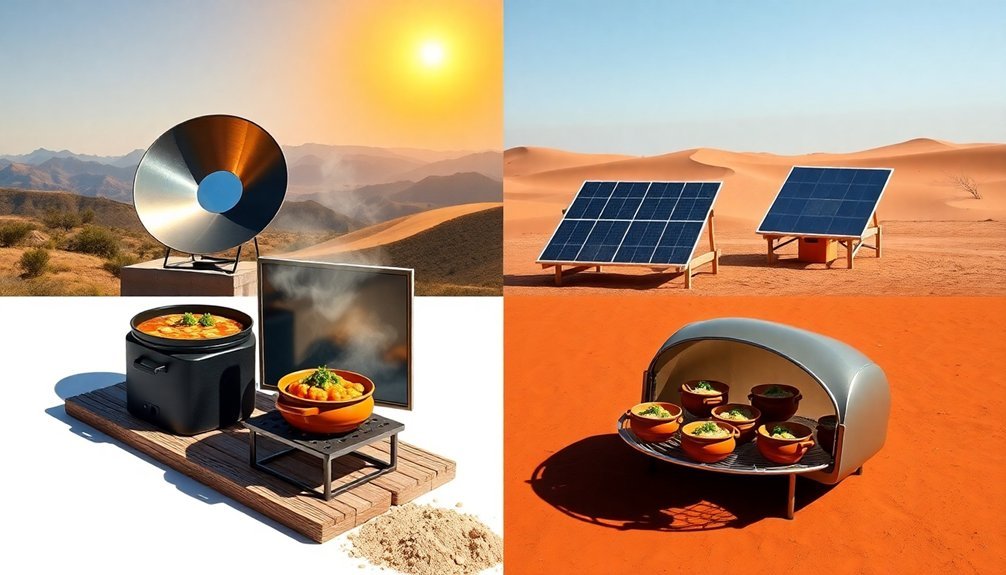
Solar cooking practices vary dramatically across different regions, adapting to local climate conditions and cultural needs. You'll find innovative approaches worldwide, from India's large-scale institutional solar steam cooking serving thousands daily to Kenya's microcredit-supported distribution programs fighting deforestation.
| Region | Solar Cooking Approach |
|---|---|
| India | Industrial-scale steam systems for mass meal preparation |
| Kenya | Community-based distribution through microcredit agencies |
| Arctic/Canada | Specialized insulated designs for limited sunlight conditions |
| American West | High-efficiency systems utilizing desert sunshine |
Even in areas with challenging weather, you can adapt solar cooking to your needs. In desert regions, you'll achieve the fastest results with parabolic cookers reaching high temperatures quickly. For cloudy climates, box cookers with extra insulation maintain steady cooking temperatures, while panel cookers offer a practical middle ground for most conditions.
Frequently Asked Questions
Can Solar Cooking Methods Affect the Nutritional Value of Meals?
Yes, solar cooking can enhance your food's nutritional value. You'll preserve more vitamins and minerals since it uses lower temperatures and gentle cooking methods, keeping up to 80% of nutrients intact in your meals.
How Do Different Fuel Types Impact the Taste of Outdoor-Cooked Food?
You'll find charcoal adds rich smokiness, gas preserves natural flavors, and wood imparts deep, smoky complexity to your food. Combining fuels like gas with wood chips gives you the best of both temperature control and taste.
What Backup Heating Methods Work Best During Unexpected Weather Changes?
You'll find portable propane heaters most reliable for unexpected weather changes. They're efficient, heat spaces up to 225 sq. feet, and can connect to larger tanks. DIY terracotta heaters work as budget-friendly backups.
How Long Can Food Stay Safely Warm in Thermal Cookers?
Your food can stay safely warm in a thermal cooker for 4-8 hours, as long as it maintains a temperature above 140°F (60°C). If it drops below this temperature, you'll need to reheat it thoroughly.
Are There Cultural Restrictions to Consider When Choosing Outdoor Cooking Methods?
You'll need to respect local traditions and sacred cooking practices. Don't use certain methods in religious areas, and always check if specific cooking styles or equipment might offend local customs or beliefs.
In Summary
You've now got the tools to cook sustainably anywhere on Earth using solar power. Whether you're in scorching deserts, humid rainforests, or snowy peaks, you'll find the right techniques to harness the sun's energy for your meals. Remember, it's not just about the equipment – it's about adapting to your local climate and seasons. Keep experimenting with these methods, and you'll become a master of climate-smart outdoor cooking.

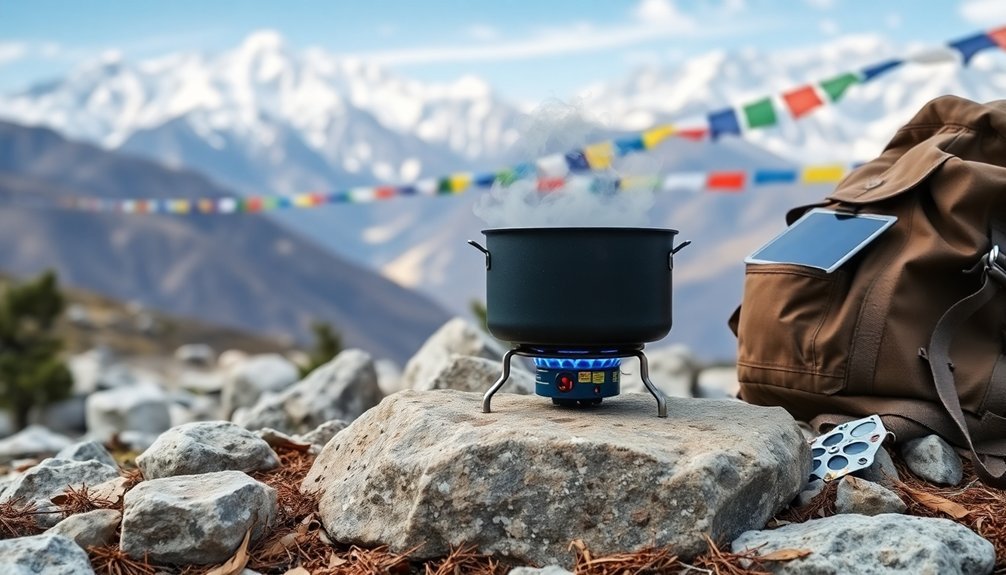



Leave a Reply